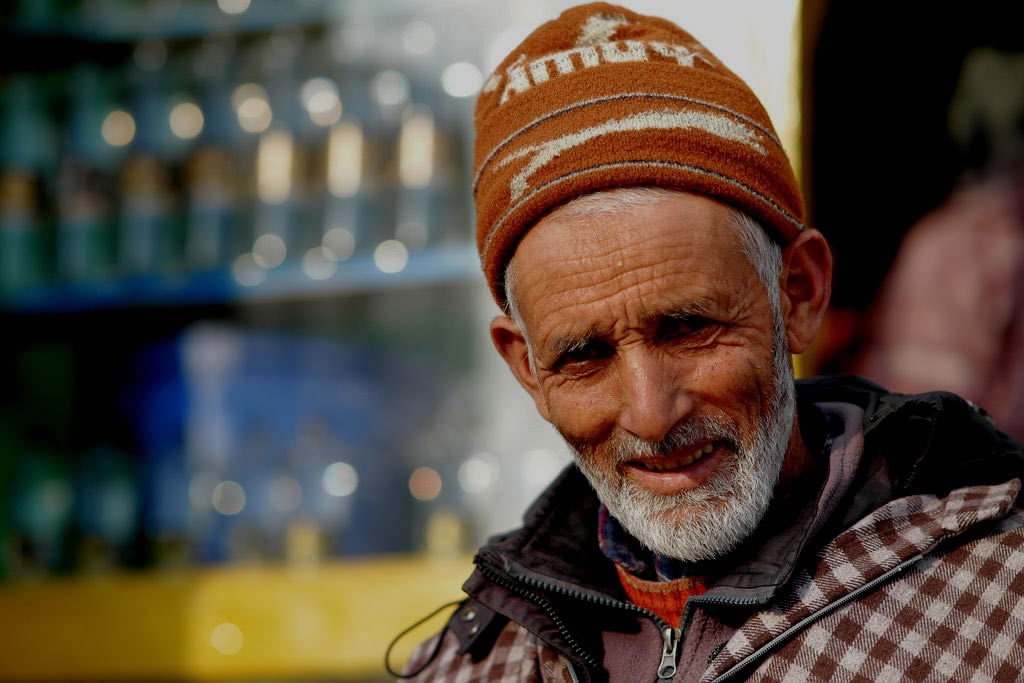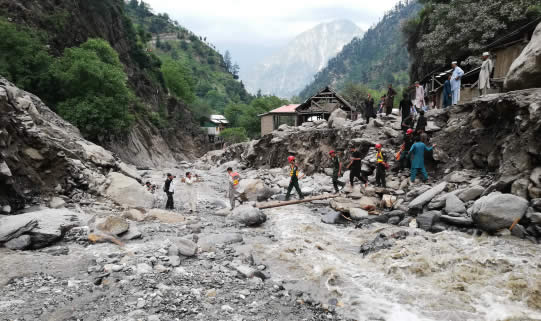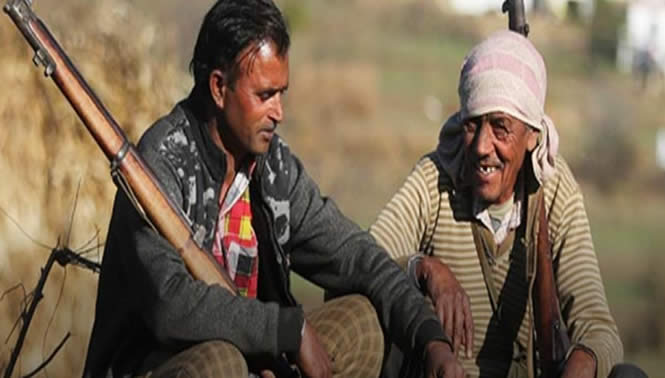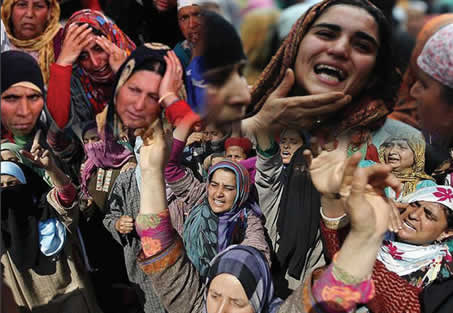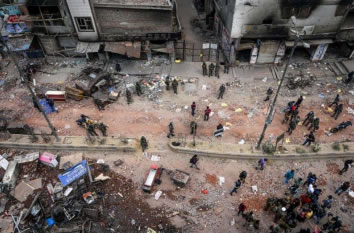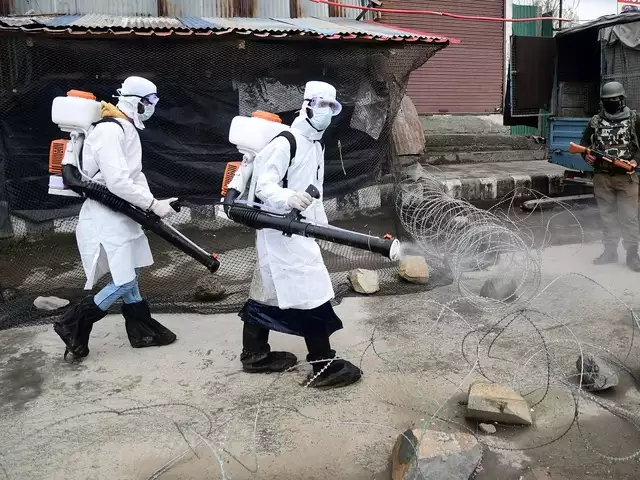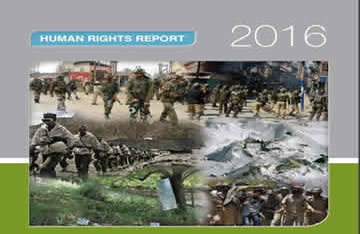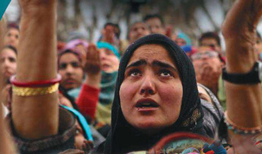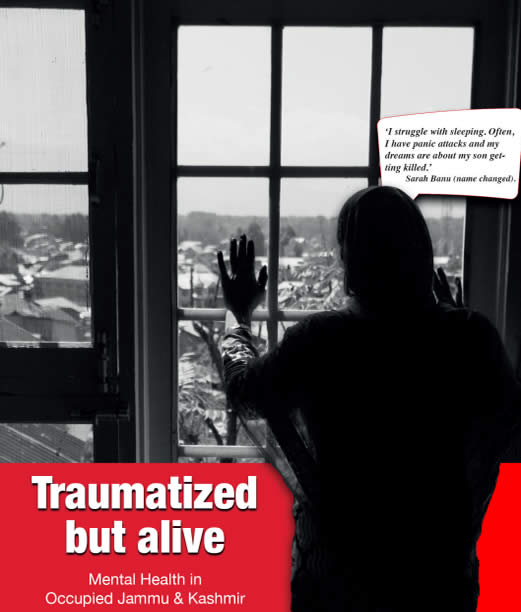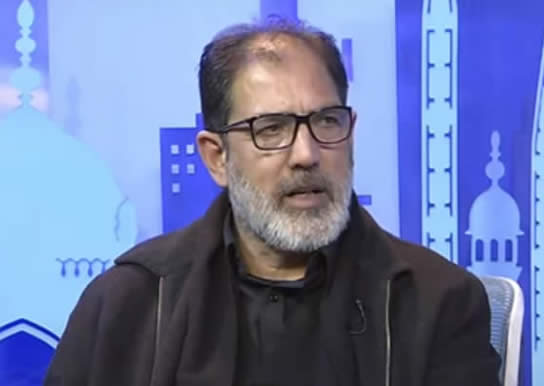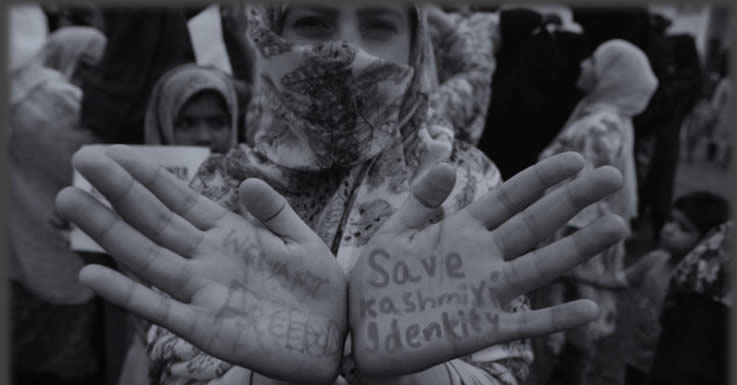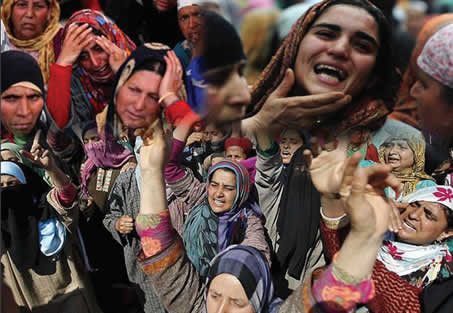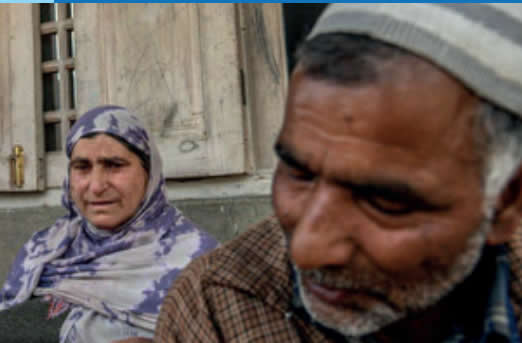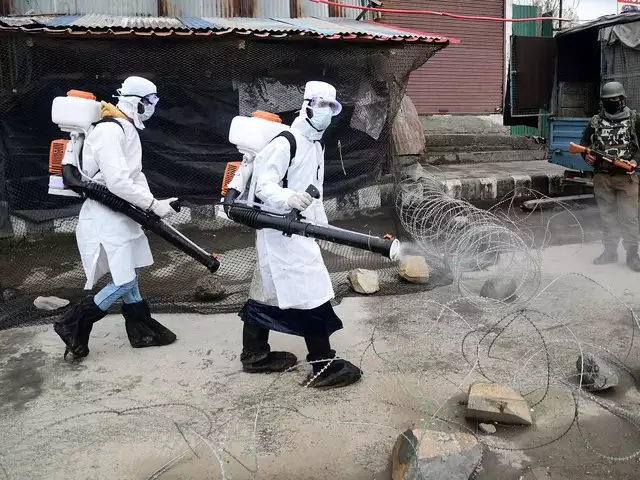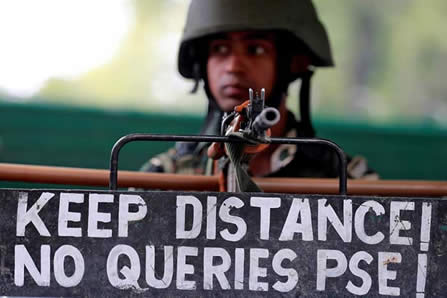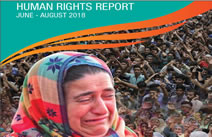THE MYTH OF PROSPERITY
THE MYTH OF PROSPERITY
Abstract
As the state machinery tightens its grip, the economic prospects for the region seem bleak. The hollow promises of integration and economic revitalization for Indian-occupied Jammu and Kashmir have only deepened the region’s alienation and economic marginalization, proving the timeless words of John F. Kennedy “The great enemy of the truth is very often not the lie—deliberate, contrived and dishonest—but the myth—persistent, persuasive and unrealistic.” The myth of economic prosperity in post-370 Kashmir has been persistently promoted, but on the ground, the reality is one of economic stagnation and disenfranchisement.
The abrogation of Article 370 has not yielded the economic dividends that the Indian government projected. Instead, it has precipitated an economic recession, aggravated structural unemployment and destabilized the traditional economic sectors in IoK, thereby undermining the region’s economic sovereignty and development trajectory. The claims of normalcy and development appear hollow when juxtaposed against the harsh economic realities faced by the Kashmiri people. This research seeks to explore the economic aftermath of 5 years of Article 370’s abrogation and analyzing the socio-economic impacts on IoK. It will investigate how the promises of development have fallen short and how the region’s economic despair mirrors its political disillusionment .Keywords: Article 370, Jammu and Kashmir, Economy, Integration, Normalcy, Unemployment, Recession, IoK
Introduction
The abrogation of Article 370 and the subsequent bifurcation of Indian occupied Jammu and Kashmir (IoK) into two Union Territories in August 2019 were marked by the Indian government as a historic move to integrate the region fully into the Indian Union and accelerate its economic development. However, the reality on the ground after five years presents a starkly different picture, particularly in terms of economic growth and the well-being of the Kashmiri people.IoK, one of over 40 global conflict zones, provides a striking example of how occupation can devastate socio- economic conditions.
The region’s occupation by a more powerful entity has led to severe restrictions on freedoms and pervasive human rights abuses, severely impacting daily life and economic stability. This situation mirrors the experiences of Western Sahara and Palestine. In Western Sahara, the Sahrawi people endure arbitrary arrests and movement restrictions under Moroccan control, crippling their economic and social opportunities. Similarly, Palestinians face frequent Israeli military operations and blockades that stifle economic activity and exacerbate humanitarian crises. These parallels highlight the broader patterns of how occupation undermines socio-economic development and human rights, affecting communities across different regions.
For the last 5 years, Indian occupation has affected not only social and cultural aspects but also political and economic aspects in Jammu & Kashmir. The current economic crisis in IIOJK is actually a sequel to unrestrained and unjustified actions by the Indian government in the past. The last five years in IIOJK has a devastating impact on the livelihoods of the kashmiris. Small businesses and shops in IIOJK are culturally colonized by the Indian government. The primary sectors including agriculture, horticulture, tourism and the handicraft industry have all been adversely affected. Many traders have shifted their trading centers from IIOJK to other parts of India and others have to find alternative ways to make money during this difficult time. IIOJK’s economy has lost around nine billion dollars and three years of development.
This section analyses how the Abrogation of Jammu and Kashmir Article 35A has impacted the economy of the Indian-occupied valley, which is in recession at a high unemployment rate and with industries collapsing and thousands becoming jobless. The UNDP-NITI Aayog’s 2023-2024 report on India’s Sustainable Development Goals (SDG) presents misleading statistics regarding Jammu and Kashmir’s progress. The report claims an improvement in the region’s score for SDG-16, which focuses on peace, justice and strong institutions—rising from 69 in 2018 to 81 in 2023-2024—it relies on selective and incomplete indicators.1 These omissions result in a distorted view of the region’s true state of peace and justice.
These reflections and observations reveal the harsh truth behind India’s claims of normalcy in Kashmir. Five years on, the region remains a land under siege, its people stripped of their rights, their economy in tatters and their voices silenced. The world must recognize this reality and challenge the false narrative of peace and progressthat India is attempting to construct.
IIOJK Economy before Abrogation of Article 370
Kashmir is a geopolitical and socio-cultural region with roots that date back centuries. Due to the conflict, there’s been not only human loss, but also an economic loss for the people living in IIoJK. In 2016, the situation worsened with the death of Burhan Wani, a pro freedom leader. His killing sparked widespread protests across IIoJK, which were met with a heavy-handed military response. The region witnessed curfews, shutdowns and internet blackouts which further crippled the economy.
The disruption in economic activity led to a significant drop in income and employment, setting a difficult stage for the region’s recovery. Before this unilateral action by the Indian government, Jammu and Kashmir had been gradually recovering from the 2016 unrest, with the state’s Net State Domestic Product (NSDP) showing promising growth at an annual rate of 13.28% between 2015 and 2019. This period of steady economic improvement signaled a path toward stability, with increasing investments and developments that hinted at a better future for the region. However, the abrogation in 2019 abruptly reversed this positive trajectory. The growth rate of NSDP plummeted to 8.73%, reflecting a blunt economic regression. Similarly, the per capita NSDP, which had previously been growing at 12.31%, also took a hit, dropping to 8.41% during the same period2 .
These figures blatantly contrast with the Indian government’s promises of economic revitalization and integration, revealing instead a reality of economic decline and unfulfilled commitments. The Indian government’s promise that the abrogation of Article 370 would bring stability, normalcy and economic prosperity to Jammu and Kashmir has not been fulfilled. Instead of the promised growth and development, the region’s economy has struggled to regain the momentum it had before the 2019 decision. Economic growth has slowed and the region is facing significant challenges in recovering its economic health. 2 Apoorvaanand, “Five Years after Abrogation, the Hinduisation of Kashmir and the Kashmirisation of India,” The Wire, Aug 7, 2024,https://thewire.in/rights/kashmir-five-years-on. This economic struggle is not happening in isolation; it is made worse by widespread human rights abuses that have occurred alongside the political and economic upheavals.
These abuses have created a situation of increased turmoil and instability in the region, counteracting the government’s claims of progress and integration. The so-called “normalcy” that the government claims to have restored in Kashmir is, in reality, a facade—a carefully constructed narrative that masks the ongoing subjugation and disenfranchisement of the Kashmiri people. Prior to abrogation of Article 370, when the world grappled with the unprecedented challenges of the COVID-19 pandemic, the situation in IIoJK was particularly dire. Indian occupied Jammu and Kashmir, already reeling from years of conflict, militarization and a fragile economic recovery, was plunged into deeper adversity as the pandemic took hold. For Kashmiris, the pandemic was not just a health crisis; it was an extension of a long-standing cycle of oppression and neglect.
The continuous negative effects of the Indian policies during COVID-19 further worsened the region’s economic woes. Many banks were burdened with distressed customers who were unable to repay their loans, leading to a surge in bankruptcies. This created an environment of economic instability, with numerous businesses either closing down or contemplating closure. Tourism, one of the main pillars of Kashmir’s economy, was particularly hard hit. The sector, which includes tour operators, travelguides, hotels, bus services, houseboats, “shikaras” (boats) and adventure sports, suffered immensely due to the declining number of tourists and the lack of job opportunities.
Pandemic and Abrogation: A Dual Crisis in Jammu & Kashmir
In the wake of the abrogation of Article 370 in August 2019, IIoJK was placed under a strict military lockdown that severely restricted movement, communication and access to essential services. This situation continued as the pandemic unfolded, compounding the region’s difficulties. While the rest of the world was mobilizing resources to combat COVID-19, the people of IIoJK found themselves doubly isolated—first by the political lockdown and then by the pandemic restrictions.
The Indian government’s response to the pandemic in IIoJK was marked by indifference and neglect. The region’s already strained healthcare system was left to fend for itself, with little to no additional support from the central government. Hospitals and clinics, which had been under-resourced for years, were overwhelmed by the surge in COVID-19 cases. There was a severe shortage of medical supplies, personal protective equipment (PPE) and even basic necessities like oxygen and ventilators. Despite the urgent need for healthcare interventions, the region’s medical infrastructure was grossly inadequate to deal with the crisis.
Moreover, the ongoing militarization exacerbated the situation. The strict curfew imposed by the military made it nearly impossible for residents to seek medical care or access essential services. Reports emerged of Kashmiris being harassed, detained and even beaten by security forces for attempting to leave their homes, even in emergencies. Doctors and healthcare workers, who were celebrated as heroes elsewhere, faced harassment and obstruction in IIoJK. The region’s limited access to high-speed internet further hindered the fight against COVID-19, as healthcare providers struggled to access critical information, including treatment protocols and research updates.
This double lockdown from 2019 to 2021 hit the already fragile economy hard. The abrogation of Article 370 in August 2019, which revoked the special status of Jammu and Kashmir, plunged the region into further economic uncertainty. The political reconfiguration led to a stringent lockdown, bringing economic activities to a standstill. Indian unilateral actions resulted in massive economic losses, disrupting trade, tourism and daily life. The economic impact was profound, with businesses suffering and public spending power diminishing drastically. This lockdown, coupled with communication blackouts, crippled various sectors and led to significant job losses.
Since the abrogation of Article 370, there has been a negative impact on Indian Occupied Jammu and Kashmir’s economy. In the first nine months alone from 3 Zafar Afaq, “J&K Suffered $5.3 Billion Economic Loss since August Last Year - a Political and Business Weekly,” August 2019 to April 2020, that number added up to around Rs 40,000 crore (USD 5.3 billion)3. This has had a ripple effect on the state’s economy and has led to a decrease in government revenue. In addition, the central government has also reduced the budgetary allocation for IIOJK. All these factors have contributed to the current economic crisis in IIOJK. Most Indian companies were unwilling to invest in the region as it was perceived as unfit for business.
Acuite Ratings & Research Limited found that about Rs 270 crore worth per day has been lost because of the 2019-2020 lockdown across India. A study by the Institute of Development and Economic Alternatives has estimated that Jammu and Kashmir’s loss to unrest is Rs1,500 crore per year. Kashmir’s share is around Rs750 crore or 0.77% of India’s GDP since Kashmir contributes 55% of the state’s GDP. The total IIOJK GDP is pegged at Rs1.3 lakh crore per annum4
.
The decline in investment undermines two key arguments central to the Indian government’s rationale for the 2019 abrogation of the region’s semi-autonomous status: that the move would enhance security and stimulate economic development. These statistics are compelling: investments in Jammu and Kashmir have plummeted by 55 percent over the last five years. In 2021-22, total investment stood at $46 million and $40 million in 2023, down from $50.5 million in 2019-2020, which is significantly less than the $102.8 million spent in 2017-
Land Grabbing
As it is mentioned above that the unjustified actions by the Indian government in the past led to the current crisis in IIOJK. In 2008, 800 Kanal of land at Baltal in South Kashmir was transferred to the Shri Amarnath Shrine Board (SASB). Much of the Jammu area is feeling economically deprived because they’ve lost land rights to Kashmiris.
From 2009-2015, the Indian army occupied 1,054,721 kanals of land in the three regions of Ladakh, Kashmir and Jammu. In the next three years (2015-2018) Indian army illegally occupied more than 4.3 lakh kanals of land in IIOJK. According to the former Chief Minister of J&K Mehboba Mufti 51,116 kanals of state land in Jammu province and 379,817 kanals of land in Kashmir and Ladakh are under unauthorized occupation by the Indian army. Indian military occupation also includes 1,526 private buildings, 280 government buildings, 14 industrial units, cinemas and 28 hotels. The Public Commission on Human Rights in 2005 identified 46 schools and educational establishments occupied by armed forces6
.
In January 2022, the Tourism Department of Indian Occupied Jammu and Kashmir allotted 1,034 kanals in Gulmarg and 354 kanals in Sonmarg, to the Indian Army as “strategic areas” for the use of armed forces in the region7 . The amendment to the Control of Building Operations Act 1988 and the J&K Development Act, 1970 allowed the authorities to carry out illegal construction in strategic areas.
Torching Public Property
The destruction of civilian property is a normal act by the Indian armed forces in IIOJK. The Indian army burns down civilians’ homes, forces families to pour kerosene into their own homes and set them on fire after siege and search operations. They also loot valuables including cash and jewelry of the civilians. In IIOJK, settler colonialism serves local small businesses and shops with an official dictate to hoist the Indian flag over their establishments on India’s Independence Day. These business and shop owners were threatened with consequences in return for not hoisting the Indian flag.
Since 1989, a total of 110,510 private properties have been destroyed during military operations, with 1,122 destroyed since 2019. In 2020, 657 homes and other public properties were destroyed, followed by 130 in 2021, 196 in 2022, 184 in 2023 while more than50 properties have been destroyed in 2024 by Indian troops.
Curfews, Lockdowns and Siege & Search Operations
The recurrent curfews and lockdowns by the Indian army are ruining the IIOJK’s economy. IIOJK witnessed an economic loss of over 21,000 crores within 3 months in 2010, 4,500
crores over 26 days of curfew following the hanging of Afzal Guru in 2013, 16000 crores for a period of five months from July 8 to November 30 in 2016, 17,878 crores in 4 months after the abrogation of Article 370 2019, more than $5.3 billion in the 10 months of lockdown
from 2019-20209 . The handicraft sector suffered a loss of around Rs 3,500 crore after the 5th Aug 2019. IIOJK witnessed 312 siege and search operations in 2020, 195 in 2021, 180 in 2022, 260 in 2023 and more than 240 operations by July 2024.10
Rising Unemployment
One of the most striking outcomes of the post-2019 economic structure in J&K is the sharp increase in unemployment, particularly among the educated youth. This demographic, which is crucial for the region’s future development, has been disproportionately affected. The promises of development and job creation made by the Indian government have not materialized in a manner that could counterbalance the economic hardships faced by the region. The unemployment rate among educated youth (aged 15-29) has surged from 21.80% in 2005 to a staggering 34.80% in 2023.
This alarming increase underscores the difficulties young people face in securing employment, even as they attain higher levels of education. The situation is even more dire for young women. In 2005, the unemployment rate among females with secondary or higher education was 40.32%. By 2023, this figure had escalated to 58.51%. This reflects not only a general scarcity of jobs but also systemic gender-based barriers that continue to hinder women’s access to employment opportunities
The Great Indian Settler Colonial Project continues in IIoJK with the help of the BJP government. Due to the minimal existence of private sector jobs, Kashmiris heavily depend on the government for livelihood. The government began hiring non-locals for jobs which were earlier only reserved for Kashmiris. Later, the government announced that these jobs will be reserved for “domiciles” of Kashmir. However, this “domicile” category includes Indian soldiers, as well as bureaucrats deputed to Kashmir along with their families and outside laborers.
After laws were set up by India to fight against “anti-India sentiment”, authorities fired hundreds of Kashmir employees who were already battered by the COVID-19 lockdown. Over 20% of Indian Occupied Jammu and Kashmir’s population remained unemployed from 2020. The average annual unemployment rate in IIOJK for 2017 was 12.98 per cent, 11.56 per cent in 2018, 16.29 per cent in 2019, 20.6% in 2020, 19.7% in 2021, 25.2 in 2022, 34.80% in 2023 and 23.09 % by July 2014.11
The abrogation of Article 370 has also led to a shift towards more precarious forms of employment, with a notable rise in the number of casual laborers. The percentage of casual laborers aged 15 and above has increased from 12.73% in 2005 to 22.02% in 2023. Casual workers often lack job stability, social security benefits and career progression opportunities, making them vulnerable to economic shocks Poverty
The poverty rate in J&K has increased from 10.35% in 2017-2018 to 12.58% in 2020-2021 and 35.26% in 2022-2023.12 The rural BPL population (people living below the poverty line who reside in rural areas) is surging and increasing from 11.54% to 16.39% and the urban poverty rate has estimated to 10%. More than 47% - 52% of the population in J&K is deprived of proper sanitation and 25% - 30% are deprived of nutrition in J&K. 13 The percentage of self-employed women living below the poverty line has fluctuated dramatically. In 2005, 14.29% of self-employed women were below the poverty line, a.
figure that spiked to 35.77% in 2019 before falling to 7.75% in 2023. These fluctuations indicate the volatility and uncertainty faced by women in the self-employment sector, likely exacerbated by the economic disruptions following the abrogation.
Demographic Shifts and Economic Displacement
The significant demographic changes will impact IIoJK’s future labor market. The projected youth population (aged 15-29) is expected to decrease from 29.3% to 25.4% by 2031. This demographic shift will have implications for the region’s workforce, potentially leading to a reduced labor supply at a time when economic revitalization is critically needed.
The socio-economic upheavals post-5 Aug have also led to changes in migration patterns, particularly related to employment. Despite the economic challenges, J&K has one of the lowest proportions of individuals migrating due to employment-related reasons, with only 38.3% of male migrants citing this as their reason for migration. This could indicate a lack of viable employment opportunities elsewhere or barriers to migration, leaving many residents trapped in a cycle of poverty and underemployment.
Undeclared Internet Shutdowns
The internet and communication blockades in IIOJK have been happening since 2005 on Independence Day and Republic Day. There have been more than 400 digital blackouts and speed throttling in IIOJK over the past decade. IIOJK has recorded the highest number of digital blackouts and speed throttling across the globe imposed by the world’s largest democratic country since Aug 05, 2019. India revoked the special status of its portion of Kashmir, known as Jammu and Kashmir, on August 5, 2019, in a bid to fully integrate its only Muslim-majority region with the rest of the country. IIOJK remained offline for 18 months which makes India the biggest violator of internet outages worldwide. The shutdown lasted until February 5, 2021
The private business directly dependent on the internet has been ruined in IIOJK. Due to the frequent internet blackout by the government, IIOJK suffered losses amounting to 4000 crore between 2012 and 2017. After the abrogation of Article 370, sectors primarily dependent on digital technologies, almost 90 percent of small businesses and dozens of students who were preparing for various competitive exams suffered the most in the absence of internet services. IIOJK witnessed around 450 internet shutdowns between the years of 2012 and 2022. There were 116 shutdowns in 2020, 85 in 2021, 146 in 2022, 58 by July 2024 while 2023 recorded the highest in the last 10 years, with a total of 171 shutdowns in IIOJK imposed by the Indian government.
Hydro Economics in IIOJK
Hydropower projects, while often touted as a renewable energy solution, have significant environmental and social impacts, particularly in ecologically sensitive regions like IIoJK. The development of these projects leads to the fragmentation of lands, disrupting ecosystems, wildlife habitats and the lives of indigenous communities. Understanding this fragmentation is crucial for assessing the broader implications of such infrastructure on the region’s biodiversity and socio-cultural fabric.
The Himalayan ecosystem, which is recognized as diverse and vulnerable, has borne the brunt of widespread and rapid land-use change associated with modern development and in recent years, landslides, floods and forest fires have further destabilized the forests and mountains. In IoJK, hydropower projects contribute to this fragmentation through a variety of mechanisms, each compounding the disruption of the region’s natural and human systems.
The International Water Management Institute (IWMI) has estimated that Indian hydro politics and policies have deprived Indian Occupied Jammu and Kashmir of around 6.5 billion rupees each year, as well as negatively impacting the potential for power generation and agriculture in the state. The dams constructed in Kashmir have deprived the locals of their resources. In IIOJK, dams have displaced about 362 families and taken 533 acres of land for fueling India’s growing economy. This has caused New Delhi to owe J&K state 20000 crores that they used as reparation for power generated from their resources.14
After the abolition of Article 370, the New Delhi state government is speeding up hydropower projects in IIOJK through National Hydro Power Corporation. Indian government plans to build 1,856 MW Sawalkot (J&K), 930 MW Kirthai-II (J&K), 500 MW Dugar (HP), 240 MW Uri-I Stage-II (J&K) and 260 MW Dulhasti Stage-II (J&K).15 The construction activities for hydropower are threatening biodiversity, impacting indigenous people 14 Bilal A. Pandow, “Economics of Kashmir Conflict”, Himalaya, the Journal of the Association for Nepal and Himalayan Studies 40, no. 1 (2020): 78-86, and fragmenting critical wildlife habitats.
These projects are not just exploitative in nature; they have resulted in losses for J&K. The geographic locations of the projects are also a problem because Kashmir is categorized in vulnerable seismic zones IV and V, where earthquakes frequently strike. This makes these dams susceptible to earthquakes and this also puts the lives of locals at risk. However, the Indian government seems least bothered about these risks or contributing to the loss of life; rather, it is interested in controlling the water resources of IIOJK. India is also working on a plan to divert the waters of Ujh, which is one of the main tributaries of the Ravi that flows into Pakistan. India’s Ministry of Environment recommends approval of her Ujh multi-purpose (hydropower, irrigation and drinking) hydropower plant in Kathua, Jammu and Kashmir, which is already declared as an ecologically sensitive area and atleast 214,502 trees will be cut down for this multipurpose project.
The Kinnaur area has 53 planned hydropower projects the total diverted forest land has 11,598 standing trees, belonging to 21 species. It is also said that in 52 villages with 3,700 families are likely to lose their homesteads as a result of the process of land acquisition due to construction of the dam and subsequent submergence area16 .The development of the Bursar dam will result in the displacement of 336 households (1,673 people) across seven villages. Overall, at least 1,052 families will be impacted including 716 households (4,659 people) on account of land acquisition 17 In Jammu and Kashmir, hundreds of thousands of trees are cut down every year for various projects such as highways, roads and dams. A rough estimate is that over 2 million trees have been cut down in the area in the last 15-20 years. This can also affect the local microclimate. These are serious concerns for local communities, whose lives and livelihoods stand adversely affected by hydropower projects.
Biodiversity at Risk
The fragmentation of land by hydropower projects has profound impacts on the region’s biodiversity. IIoJK is home to a variety of wildlife species, many of which are dependent on large, contiguous habitats for their survival. In mountainous regions like IIoJK, wildlife often migrates to lower altitudes during the harsh winter months in search of food and water. The construction of hydropower projects in these lower-altitude areas, as observed near wildlife sanctuaries, interrupts these migration routes, forcing wildlife into smaller, isolated areas where resources may be scarce.
The disruption of land connectivity prevents the free movement of species, which is essential for maintaining genetic diversity and population stability. Fragmented habitats can lead to smaller, isolated populations that are more vulnerable to extinction. Furthermore, the creation of new edges in the areas where forest meets cleared land or infrastructure, can alter the local microclimate and expose species to new predators or human activities. These edge effects can further degrade the habitat and reduce its suitability for native species.
Sectoral Analysis
i. Trade & Tourism
Indian government’s cross-LoC trade suspension order on April 18, 2019 affected more than 1700 traders in IIOJK. From 2019- 2022, India’s occupation of Jammu and Kashmir has led to more than $7 billion in economic losses18 The existing economy in this region is on the verge of collapse. Local businesses don’t have much hope for new investments, owing to the fact that it needs a credible economic policy. Only in the first three months after 5th Aug 2019, 71 percent of revenue decline in the tourism sector.
Tourism, once a thriving sector in IIoJK, has been one of the hardest-hit industries post-August 2019. The abrogation of Article 370 led to immediate and severe disruptions in tourist arrivals, which were further exacerbated by the COVID-19 pandemic. The restrictions following the political changes led to a significant decline in tourist arrivals, resulting in financial losses amounting to millions of rupees. Hotels in popular tourist destinations like Srinagar, Gulmarg and Pahalgam reported low occupancy rates, adding to the economic distress.
The number of tourists fell from 316,424 in 2018 to 43,059 in 2019, marking a sharp 86 percent decline, leading to a near-complete shutdown of the tourism industry resulting in sustained revenue losses for hotels, tour operators and other related businesses. However, in 2020, 2021, 2022 and 2023, there were 3.4 million, 11.3 million, 18.8 million and 21.1 million tourists respectively.19 The influx in the number of tourists occurred due to the Amarnath Yatra, a pilgrimage to the Amarnath cave in Jammu and Kashmir. The government extended the duration of the yatra, allowing pilgrims to stay longer, which led to an increase in the number of yatris.
ii. Manufacturing & Handicrafts
Although manufacturing sector comprises a small portion of the economy, employing around 3.5% of the working population, the manufacturing sector faced severe losses due to the prolonged lockdowns. The handicrafts sector, providing income to over three lakh artisans and contributing Rs 1700 crore annually to exports, was devastated by the communication blockade post 5 Aug. This sector, employing 7% of the workforce, saw a drastic decline in productivity and income.
iii. Transport and Infrastructure
The transport sector, a vital component of the economy, was paralyzed by the lockdowns. The Jammu and Kashmir State Road Transport Corporation (JKSRTC) reported a loss of Rs 5.25 crore in 2019. The halt in transport activities affected related businesses, such as mechanical workshops, petrol pumps and service stations.
To facilitate the movement of military machinery, materials and personnel, extensive networks of roads are constructed. These roads cut through forests, meadows and river valleys, creating barriers for wildlife movement and fragmenting habitats. For example, roads constructed for military purposes including specialized routes built for troop movement, logistics and tactical advantage disrupt the natural continuity of the landscape.
The establishment of powerhouses, transmission lines and project colonies further fragments the landscape. Forest land is often cleared to erect transmission towers and other infrastructure, which leads to the loss of forest cover and creates new edges. These edges are vulnerable to exploitation, such as logging or agricultural expansion, further degrading the habitat.
iv. Agriculture and Horticulture
Since 2019, Kashmir’s export-based economic industries which include the agricultural and horticultural industries, also have had a negative effect. Agriculture, a primary sector in the region, suffered severely from curfews and lockdowns. Some 60% of employment in the region comes from agriculture, which has contributed poorly to Gross State Domestic Product (GSDP). In essence, this means that 60% of people are becoming poorer due to an imbalance between the average incomes of farmers and non-farmers 20 . The overall agricultural sector also suffered from disrupted supply chains and market access, leading to reduced productivity and income for farmers.
In IIoJK horticulture is a source of livelihood for over 3 million people and 70% of the work force directly or indirectly dependent on agriculture for its livelihood. The Horticulture sector is a source of livelihood for about 43 lac population in Jammu and Kashmir. The horticulture accounts Rs 15413 crore, livestock and animal husbandry generate Rs 12634 crore while basic agriculture contributes for just 9512 crore to the state GDP.21
The harvest of cherries, pears and almonds suffered an estimated 70% damage due to lockdowns, particularly in Srinagar, Ganderbal and Tangmarg. This resulted in losses amounting to millions of rupees. The industry continued to struggle, with losses over these five years remaining equally staggering, leaving fruit growers facing significant economic hardships. The apple industry, a vital component of this sector, was particularly hard hit, with losses ranging from 50% to 80% in key areas like Kupwara, Baramulla, Trehgam and Rafiabad. This decline has directly impacted the livelihoods of approximately 7 lakh farming families, affecting millions of people associated with the horticulture sector. Shopian, known as the “apple bowl” of India, faced substantial losses.
The lockdowns led to the proliferation of fake and substandard pesticides, damaging crops and causing diseases like scab. This resulted in a sharp decline in apple prices and significant economic losses for the Rs 10,000 crore horticulture industry, which supports 3.5 million people. In the last two decades, The decline in growth graph of horticulture and agriculture sectors in Jammu and Kashmir has shown trough in its contribution to the State GDP from 38% in 1990 to 30% in 2000 to 16.5% by 202122 Department of Agriculture & Farmers Welfare Jammu and Kashmir data was reported at 3,912.910 Ton in 2020-2021 and 3139.45 in 2022-2023.
In IIoJK, the production of horticulture crops such as Saffron, Walnuts, Apples and agriculture crops including wheat, maize and rice have decreased. Many villages and farmers who were solely dependent on the horticulture crops and towns known for particular crop production have been in strain due to the change and loss brought by the new agricultural and land use policies introduced after 5th Aug in IIOJK. Recent Indian trade regulations impact Kashmiri apple growers.
Cutting off Kashmiri businesses from cross-border trade has started to hurt the once-booming fruit industry of the region. India has been making concrete efforts to destroy it by constraining Kashmiri apple growers from selling their crops on the Indian market. These efforts include strangulating 8000 fruit-laden trucks on highways for weeks altogether, facilitating the illegal import of Iranian apples into the Indian market and driving rates down dramatically as well as causing huge losses to Kashmiri traders.
Kashmir’s famed saffron fields, once a symbol of prosperity and the pride of the region, are now under siege from multiple fronts. Over the past few years, saffron cultivation in Kashmir has faced numerous challenges, including a dramatic decline in production, which dropped from 8.0 tons in 2010-11 to 2.6 tons in 2023-24, representing a staggering 67.5% decline 23 Prolonged periods of curfews, lockdowns and poor technical support have severely impacted production. Secondly, the influx of cement dust from nearby cement plants further compounds the challenges faced by saffron farmers, contributing to the decline in production.
Furthermore, the Indian market is being flooded with tax- free Iranian saffron, sold at lower prices, making it more appealing to consumers and posing stiff competition to Kashmiri saffron. The saffron fields are facing existential threats, leading many farmers to abandon saffron cultivation in favor of other crops. The walnut industry in IIoJK, historically a significant contributor to the region’s economy, has been particularly vulnerable to the economic changes post-2019. The industry has been undermined by government’s undeclared lockdowns, falling prices, reduced demand and increased competition from imported walnuts from.
Afghanistan, China, Chile and California. The introduction of a 5% Goods and Services Tax (GST) on Kashmiri walnuts, combined with the removal of tariffs on imported nuts from the United States, has created an uneven playing field. Local walnut prices have plummeted from Rs 1,300 per kilogram to Rs 600-700 per kilogram, leading to drastic reductions in profitability. The walnut industry’s production has also decreased significantly, dropping from 2.22 lakh metric tons in 2010-11 to 1.80 lakh metric tons in 2019-20, a 19% decline over nine years.
This downturn has led to substantial economic displacement, with over 50% of traders and growers in the Lagama market, historically a hub for walnut trade, abandoning the business. The new trade policies introduced by Indian government and reduced demand have also led to a significant drop in per capita income for walnut growers, from Rs 15-20 lakh to Rs 4-5 lakh. The livelihoods of over 10,000 families in Uri, dependent on the walnut industry, are now at risk. The import of walnuts is even worse with rates nearly falling down to zero for local producers. India produced 2.82 lakh tons of walnuts in 2021-22 with IIOJK accounting for around 92 per cent of the produce.
In 2022-23, India imported 27,455 metric tons of walnuts from Chile, up from 11,434 metric tons in 2021-22 and 5,285 metric tons from the US, compared to 3,564 metric tons in 2020-21 from the UAE, resulting in heavy losses for Kashmiri traders.24 Despite high demand, the local crop from Kashmir is insufficient to meet the needs.
This has caused a reduction in prices of Kashmir walnuts over the years, despite their superior quality, with the price differential narrowing to just Rs 200 to Rs 250 per kg. Moreover, the nutritional superiority of Kashmir walnuts is hindered by transportation issues, with long-distance travel resulting in rejected kernels due to darkening. Due to the imposition of various taxes such as GST and VAT, walnut cultivation has been continuously decreasing from 47,004 hectares in 2017-18, to 46,118 hectares in 2018-2019, 46,175 hectares in 2019-2020, 46,134 hectares in 2020-2021, 46,197 hectares in 2021-2022 and finally to 46,011 hectares in 2023.
.
The chilgoza tree is a rare and endangered species of evergreen pine that is indigenous to the western Himalayan region providing edible nuts and its loss is a cause for concern in this region. The chilgoza’s contribution to local income has decreased, with apple and off-season vegetable cultivation being the primary contributors, it still forms a substantial part of the economy in villages well-endowed with chilgoza forests, with fewer orchards. The net farm land area across Jammu and Kashmir has fallen from 70% -75% of the available arable land to 65% - 70% in the last few years. The yield of rice per hectare has gone down by around three tons.
v. Arts & Crafts Industries
The Indian government’s decision to abrogate Article 370 on the 5th of August 2019 has already impacted the local economy by causing unintended consequences that have amounted to over $2.4 billion27 . The years 2019- 2020 and 2021-2022 saw a huge setback for the arts & Crafts industry which witnessed unprecedented losses during this period. IIOJK is currently experiencing harvest losses of 40-45 percent. The decision has jeopardized the economy of Indian Occupied Jammu and Kashmir, an economic system that could have been enhanced to provide for the needs of its people as well as serve developmental aims.
Conclusion
For the rest of India, August 5 is celebrated as a day of triumph, a day when Kashmir was supposedly brought fully under the Indian Constitution. But this celebration is a grotesque mockery of the reality on the ground. What is seen as a victory for the Indian state is, in truth, the crushing of an entire population’s spirit and identity. As one Kashmiri might reflect, “The soul of Kashmir is shackled and its breath stifled by the iron grip of power.” This brutal imagery captures the essence of the so-called normalcy that the Indian government boasts about. Kashmir is now a place of violence, where culture and traditions are trampled upon. The economic blockade imposed by India on the state of Jammu & Kashmir has triggered a prolonged socioeconomic crisis in the occupied territory.
The plight of Kashmiris became even more difficult after the abrogation of article 370 on August 05th, 2019. The Indian government’s presence in Kashmir has led to a series of atrocities against civilians, leading to mass killings, arrests, disappearances and torture. The situation is dire for the people of Jammu & Kashmir, who are suffering from unemployment and poverty at an unprecedented level. Kashmir is facing an unprecedented humanitarian crisis due to the terror created by Indian occupation forces in Jammu & Kashmir.
The situation in IIoJK needs to be de-escalated and the people must be freed from the yoke of violence imposed by India. The international community has failed the Kashmiri people despite its constant outcry on human rights abuses. The UN should take an active part in resolving the Indo-Kashmir dispute and help resolve the decades-old dispute.
Related Reports
